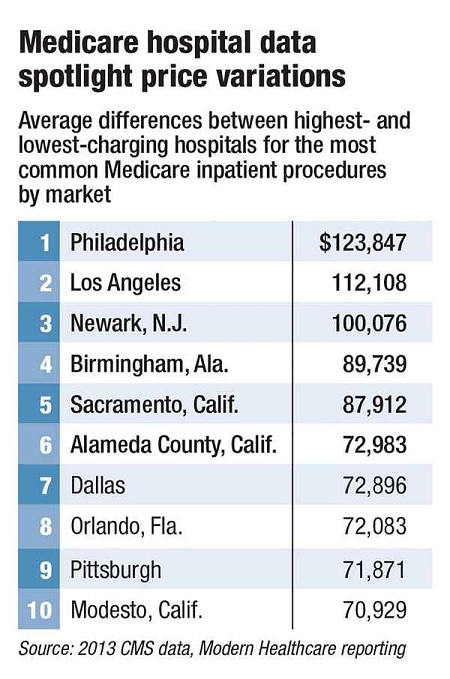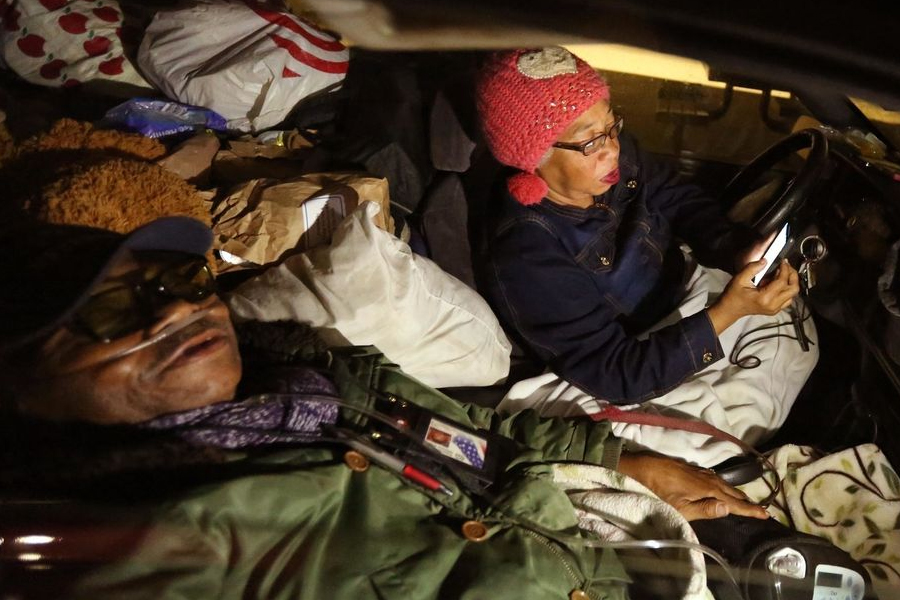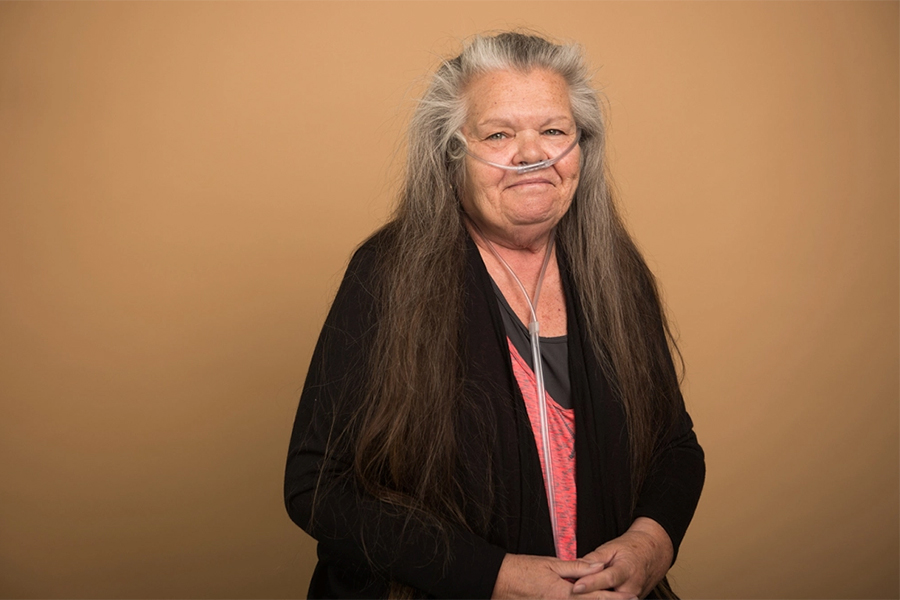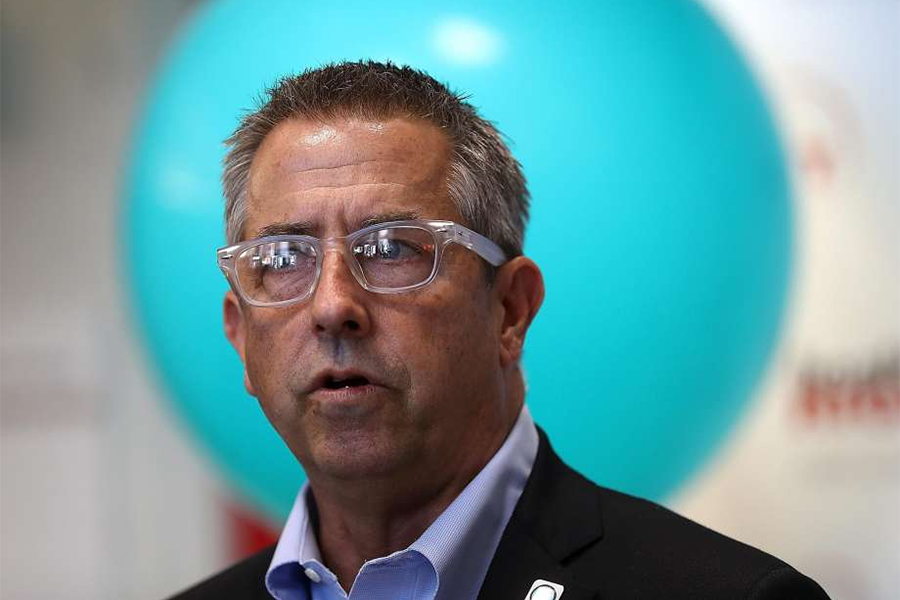Hospital list prices varied sharply within individual markets, with the highest-priced hospitals routinely charging more than five times the rates of the lowest-priced facilities in the same area, new CMS data show. Those high retail prices have become a growing concern as more patients face unexpected out-of-network bills.
The CMS released fiscal 2013 data last week on the average amount billed by 3,290 hospitals for the 100 most common inpatient and outpatient procedures, and the average amount paid by Medicare. On the inpatient side, the data showed chargemaster prices increased by about 10% from 2011 to 2013 even though healthcare spending grew at a much lower rate.
The highest charges for 14 of the 15 most common Medicare inpatient procedures among all U.S. hospitals in 2013 were at facilities owned by for-profit CarePoint Health in New Jersey. At CarePoint’s Bayonne (N.J.) Medical Center, the list price for treating chronic obstructive pulmonary disease patients averaged almost $208,000. CarePoint’s Christ Hospital in Jersey City charged nearly $223,000 for patients with severe sepsis.
The national average hospital charge for severe sepsis was $48,465, with the lowest being $7,178.
“The market is totally out of whack,” said Gerard Anderson, a health policy and finance professor at Johns Hopkins University.
Those sticker prices mean little to Medicare, though they do factor in to what the program pays for high-cost “outlier” cases. Medicare pays hospitals scheduled amounts, and hospitals can receive add-on payments if they are a teaching facility or treat high volumes of poor patients.
But experts note that charges are the basis for hospitals’ rate negotiations with private insurers. In addition, some patients are directly affected by the list prices. For instance, CarePoint does not have contracts with some major insurers in its service area, so insured patients treated at CarePoint facilities—and their insurers—sometimes face those high retail prices.
“Many people believe that the chargemaster file is irrelevant,” Anderson said. “But if you are uninsured, it’s clearly not. (And) if you got an out-of-network provider, you’re most likely to feel the effect of these very high charges.”
Hospitals generally contend the chargemaster prices are misleading because very few patients receive a bill based on those rates, and the payments hospitals actually receive are much lower. For example, Medicare paid hospitals 22% of their charged amount for major joint replacement surgeries, the most common inpatient procedure, according to the CMS data.
But a growing number of Americans are covered by high-deductible health plans with narrow provider networks. When patients go to an out-of-network facility or unwittingly receive care from an out-of-network doctor, they may be liable for the high retail prices. Their insurers also may be on the hook if they don’t have a contracted rate with the provider.
For hospitals, staying out-of-network is a “growing strategy,” said Paul Ginsburg, a health economist at the University of Southern California.
A CarePoint spokesman said retail prices affect less than 7% of its facilities’ patient encounters. When CarePoint bought its three hospitals out of bankruptcy, he said, private insurers were paying them below Medicare rates. The system tried negotiating higher rates, but insurers didn’t budge. “Being out-of-network is not a business strategy; it is a survival strategy,” he said. “We would like to be in-network with every insurer in our state provided they could offer us a workable rate of reimbursement that takes into account our obligation to provide care for the underinsured and uninsured.”
Providers charging retail prices for out-of-network services has strained relationships with insurers, and patients are caught in the middle. Clare Krusing, spokeswoman for America’s Health Insurance Plans, said her group has found that out-of-network prices are “exorbitant.”
Some states, including New Jersey, have proposed limiting the amount hospitals can charge for out-of-network services. Hospitals have opposed such caps. CarePoint argues that if hospital prices are going to be regulated, the state should establish an all-payer rate-setting system to create a level playing field for all plans and providers.
“Many of the recent discussions about capping out-of-network payments to hospital providers are simply a ruse to protect insurance company profits and enable insurers to maintain the advantage when negotiating their reimbursement agreements with hospitals,” CarePoint CEO Dennis Kelly said in May.
Nevertheless, hospitals across the country, perhaps spurred by transparency initiatives such as the CMS’ annual hospital data release, have been working with outside contractors to update their chargemaster price lists. “They’re trying to get a better understanding of where they are out of line in their charging,” said Kathy Schwartz, product manager at revenue-cycle management company Craneware.
David Lansky, CEO of the Pacific Business Group on Health, a San Francisco-based coalition of large healthcare purchasers, urges moving beyond examining retail prices to publishing actual negotiated rates between insurers and providers. Those typically are hidden by confidentiality clauses in contracts. Revealing those rates would help employers and consumers in seeking out lower-cost care and indicate how aggressively insurers are working to keep costs down, he said.
Original article authored by Bob Herman of Modern Healthcare on June 6, 2015






















